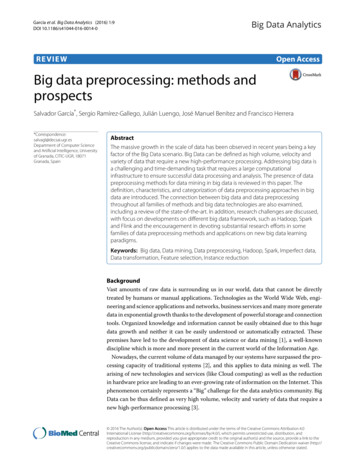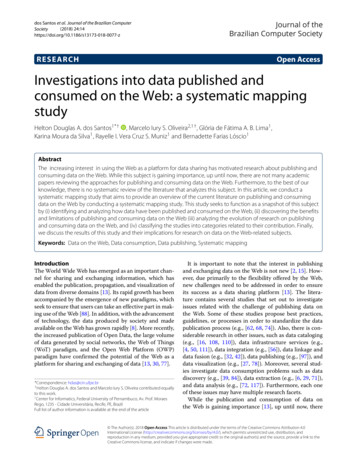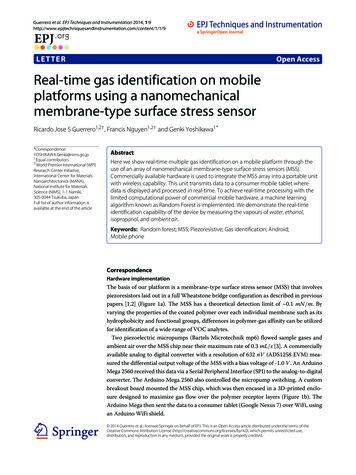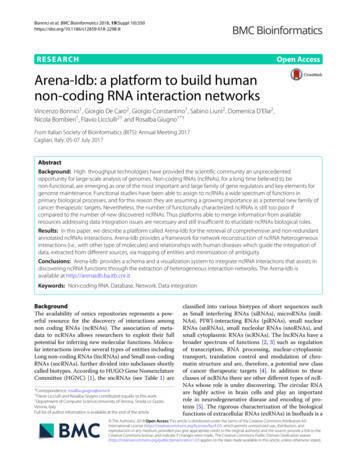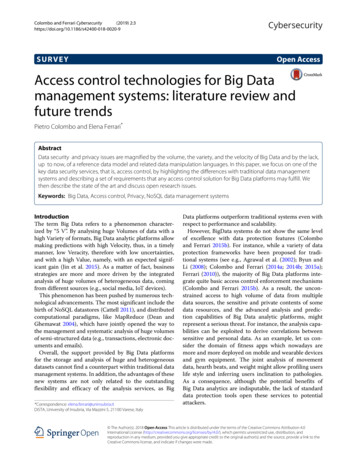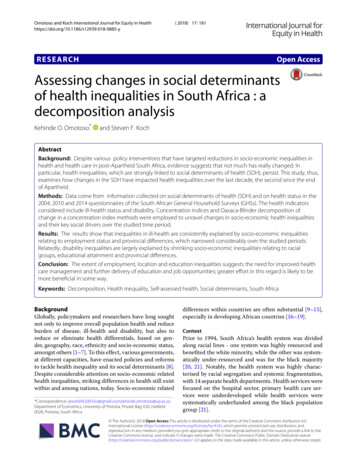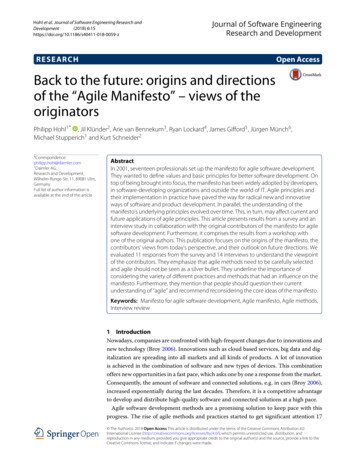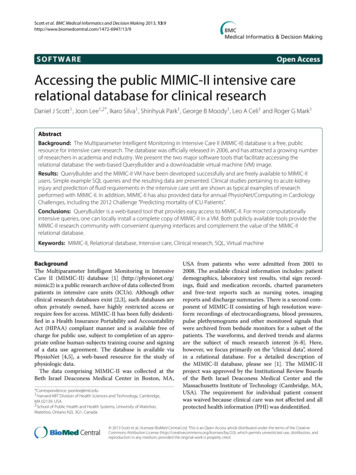
Transcription
Scott et al. BMC Medical Informatics and Decision Making 2013, TWAR EOpen AccessAccessing the public MIMIC-II intensive carerelational database for clinical researchDaniel J Scott1 , Joon Lee1,2* , Ikaro Silva1 , Shinhyuk Park1 , George B Moody1 , Leo A Celi1 and Roger G Mark1AbstractBackground: The Multiparameter Intelligent Monitoring in Intensive Care II (MIMIC-II) database is a free, publicresource for intensive care research. The database was officially released in 2006, and has attracted a growing numberof researchers in academia and industry. We present the two major software tools that facilitate accessing therelational database: the web-based QueryBuilder and a downloadable virtual machine (VM) image.Results: QueryBuilder and the MIMIC-II VM have been developed successfully and are freely available to MIMIC-IIusers. Simple example SQL queries and the resulting data are presented. Clinical studies pertaining to acute kidneyinjury and prediction of fluid requirements in the intensive care unit are shown as typical examples of researchperformed with MIMIC-II. In addition, MIMIC-II has also provided data for annual PhysioNet/Computing in CardiologyChallenges, including the 2012 Challenge “Predicting mortality of ICU Patients”.Conclusions: QueryBuilder is a web-based tool that provides easy access to MIMIC-II. For more computationallyintensive queries, one can locally install a complete copy of MIMIC-II in a VM. Both publicly available tools provide theMIMIC-II research community with convenient querying interfaces and complement the value of the MIMIC-IIrelational database.Keywords: MIMIC-II, Relational database, Intensive care, Clinical research, SQL, Virtual machineBackgroundThe Multiparameter Intelligent Monitoring in IntensiveCare II (MIMIC-II) database [1] (http://physionet.org/mimic2) is a public research archive of data collected frompatients in intensive care units (ICUs). Although otherclinical research databases exist [2,3], such databases areoften privately owned, have highly restricted access orrequire fees for access. MIMIC-II has been fully deidentified in a Health Insurance Portability and AccountabilityAct (HIPAA) compliant manner and is available free ofcharge for public use, subject to completion of an appropriate online human-subjects training course and signingof a data use agreement. The database is available viaPhysioNet [4,5], a web-based resource for the study ofphysiologic data.The data comprising MIMIC-II was collected at theBeth Israel Deaconess Medical Center in Boston, MA,*Correspondence: joonlee@mit.edu1 Harvard-MIT Division of Health Sciences and Technology, Cambridge,MA 02139, USA2 School of Public Health and Health Systems, University of Waterloo,Waterloo, Ontario N2L 3G1, CanadaUSA from patients who were admitted from 2001 to2008. The available clinical information includes: patientdemographics, laboratory test results, vital sign recordings, fluid and medication records, charted parametersand free-text reports such as nursing notes, imagingreports and discharge summaries. There is a second component of MIMIC-II consisting of high resolution waveform recordings of electrocardiograms, blood pressures,pulse plethysmograms and other monitored signals thatwere archived from bedside monitors for a subset of thepatients. The waveforms, and derived trends and alarmsare the subject of much research interest [6-8]. Here,however, we focus primarily on the “clinical data”, storedin a relational database. For a detailed description ofthe MIMIC-II database, please see [1]. The MIMIC-IIproject was approved by the Institutional Review Boardsof the Beth Israel Deaconess Medical Center and theMassachusetts Institute of Technology (Cambridge, MA,USA). The requirement for individual patient consentwas waived because clinical care was not affected and allprotected health information (PHI) was deidentified. 2013 Scott et al.; licensee BioMed Central Ltd. This is an Open Access article distributed under the terms of the CreativeCommons Attribution License (http://creativecommons.org/licenses/by/2.0), which permits unrestricted use, distribution, andreproduction in any medium, provided the original work is properly cited.
Scott et al. BMC Medical Informatics and Decision Making 2013, 13:9http://www.biomedcentral.com/1472-6947/13/9As of the end of 2012, over 500 users have beenapproved for access to the MIMIC-II relational database,which reflects researchers’ interest in the clinical data ofMIMIC-II. Numerous innovative and significant studieson a broad range of topics are based on MIMIC II andestablish its importance. The software tools that make itfeasible for a large worldwide community of investigators to draw on MIMIC II are essential contributors toits value and utility for intensive care research. Providing public access to a relational database for users whoare geographically separated and from a wide range ofbackgrounds is a challenging task. While there are toolsavailable for web-based administration such as phpPgAdmin [9] and even searching of clinical data [10], theyare not always appropriate in any given situation. ForMIMIC-II, we have developed an easy-to-use, read-onlyinterface capable of performing exploratory searches anda more powerful tool for complex data processing. Thesetwo access tools currently serve as the main gatewaysto the MIMIC-II relational database. In the present article, we describe their implementations and vital roles inconducting clinical research using MIMIC-II.ImplementationThe MIMIC-II relational database (version 2.6) containsrecords from over 32,000 subjects, including over 7,000neonatal patients. The raw data is stored in various basetables, generally organized by subject, hospital and ICUstay IDs. Several database views, which summarize andcollate information, have been generated to allow users tobecome familiar with the available data and to find recordsof interest. Users can access the database via a web-basedonline tool (QueryBuilder) and a downloadable virtualmachine (VM) image, which are discussed in the ensuingsections. Flat file exports of the database tables and a PostgreSQL compatible dump file are also available, but arenot discussed here. To the best of our knowledge, there areno other publicly available software tools that allow usersPage 2 of 7to query a clinical database in SQL (Structured QueryLanguage), either in a web-browser or in a virtual machineenvironment.QueryBuilder web-based toolQueryBuilder is a web-based database query tool developed using the Google Web Toolkit (GWT) [11] andExtGWT widget library [12]. Figure 1 shows the systeminfrastructure. The QueryBuilder application is hosted ona Tomcat 7 application server and connects to an Oracle 11g database containing clinical data from MIMIC-II.Queries are submitted to the application server using aGWT Remote Procedure Call (RPC) and are executedin the database using Java DataBase Connectivity (JDBC)[13]. The results are passed back through the applicationserver to the user’s web browser.The GWT framework allows developers to write codein Java, which is then compiled into a highly optimizedbrowser-independent JavaScript web application. GWTprovides a “development mode” in which the Java codeis dynamically translated to JavaScript and displayedusing a browser plugin. For production systems, GWTbuilds a Web application ARchive (WAR) file containingoptimized JavaScript that works across a wide range ofbrowsers and platforms. The WAR contains Java servletsfor server side processing and can be deployed on anystandard application server.QueryBuilder, which is accessible through desktop ormobile web browsers, allows users to explore the structure of the various tables and views in the databaseand to examine the relationships among them. SQLqueries allow users to examine and process the data asdesired; the resulting datasets can be exported in CSV(Comma-Separated Values) format for further processing.In order to prevent a given user from excessively consuming shared resources on QueryBuilder (e.g., exporting alltables in MIMIC-II), we limited the maximum number ofexportable rows to 1,000.Figure 1 QueryBuilder system infrastructure. The user connects to QueryBuilder using a web browser. When the user submits an SQL query, it istransmitted to the application server and executed on the database server via JDBC. The query results are returned to the user via the applicationserver and displayed.
Scott et al. BMC Medical Informatics and Decision Making 2013, tual machineThe increasing number of users, and their desire torun more complex queries, has begun to overload thecomputer systems hosting QueryBuilder. To mitigate thisproblem, we have developed a system allowing users torun a copy of the relational database on their own computers, providing much faster, uncongested access usinga VM. A VM is a completely isolated operating systeminstallation that can be run within a host environment.The MIMIC-II VM employs Oracle’s VirtualBox virtualization environment, providing an Ubuntu 10.04 Linuxoperating system distribution and a pre-configured PostgreSQL 8.4 database server.To use the MIMIC-II VM, users must first install theVirtualBox host software, and download the MIMIC-IIVM image for import into VirtualBox. Once the VM hasbeen started, a simple script will download and importthe MIMIC-II database into the local PostgreSQL server.The resulting system contains a complete clone of theMIMIC-II relational database that can be queried usinga command line client, a GUI (Graphical User Interface)desktop application (pgAdmin III), and JDBC interfaces.The VM also includes an SQL cookbook which is a compilation of example SQL queries that users can use as astarting point for their research studies.We also created a demo VM (and, to suit users’ preferences, a bootable ISO image) containing data from 4,000patients who have been deceased for two years or more.Since the demo VM and the ISO image contain neitherPage 3 of 7PHI, nor free text, nor any data from recently living individuals, they are exempt from HIPAA restrictions, andinterested researchers may download them freely.ResultsBoth QueryBuilder and the MIMIC-II VM are currentlyavailable to MIMIC-II users free of charge. A link toQueryBuilder, the downloadable VM image, as well asrelated documentation and instructions for gaining accessare available on PhysioNet (http://physionet.org/mimic2).Figures 2 and 3 are screenshots of QueryBuilder and theVM, respectively.Both QueryBuilder and the VM are routinely usedby researchers around the world. As of November 6,2012, 508 MIMIC-II users have a QueryBuilder account.Between January 1 and November 7, 2012, an average of4.5 users logged into QueryBuilder per day and a total of221 unique users logged in at least once. The VM withcomplete data have been downloaded 129 times betweenJuly 2011 and October 2012, whereas the demo VMand bootable image have been downloaded 2,234 timesbetween August 2011 and October 2012.Although QueryBuilder and the VM provide immediateaccess to the MIMIC-II relational database, the user needsto have working knowledge in both SQL and the MIMICII database schema. SQL is a rare skill among clinicians,and becoming familiar with the structure of the MIMIC-IIclinical data requires substantial time and effort. In orderto guide new MIMIC-II users, we present a few exampleFigure 2 QueryBuilder screenshot. A screenshot of QueryBuilder, showing information about the CHARTEVENTS table in MIMIC-II.
Scott et al. BMC Medical Informatics and Decision Making 2013, e 4 of 7Figure 3 MIMIC-II VM screenshot. A screenshot of the MIMIC-II virtual machine, showing the D PATIENTS table in pgAdmin.queries and research studies in the subsequent sections.We recommend using QueryBuilder for the simple example queries in Section “Example usage” and using theVM for the computationally expensive studies in Section“Applications”.query to obtain ICU stays of interest. The second examplequery obtains all ICU stays for patients who have a SAPS(Simplified Acute Physiology Score) I [14] score between15 and 20, are between 20 and 30 years old, had 2 ICUadmissions in total and died in the hospital.SELECT icustay id, subject id, gender, dob, dodFROM mimic2v26.icustay detailWHERE icustay admit age BETWEEN 20 AND 30AND sapsi first BETWEEN 15 AND 20AND subject icustay total num 2AND hospital expire flg ‘Y’Example usageThe ICUSTAY DETAIL view summarizes ICU stays forall patients and can be used to obtain general statistics forthe entire population of MIMIC-II. The following example query obtains ICU mortality statistics broken down bygender.SELECT gender, icustay expire flg, COUNT(*)FROM mimic2v26.icustay detailWHERE subject icustay total num 1GROUP BY gender, icustay expire flgThe results from this query are shown in Table 1, whichindicates that among patients with only one ICU stay inthe database, there are more males than females, and thatmales have a lower ICU mortality rate (6.2%) than females(7.2%). One can obtain hospital mortality by querying thehospital expire flg.The ICUSTAY DETAIL table is also used to obtainpatient cohorts by using the WHERE clause to restrict theTable 1 ICU mortality statisticsgendericustay expire flgMYcount (*)958MN14393FY876FN11207(null)Y2(null)N43ICU mortality statistics generated by executing the example query. There aresome people for whom gender was not recorded, indicated by ‘(null)’.
Scott et al. BMC Medical Informatics and Decision Making 2013, e 5 of 7Table 2 Specific patient cohorticustay idsubject idgenderdobdodresults. The rich, detailed information it contains hasstimulated a variety of research 9Results of the example query in the text. ICUSTAY ID and SUBJECT ID identifythe ICU stay and the patient; DOB and DOD are surrogate dates of birth anddeath; see text for discussion.The query returns three rows as shown in Table 2(for patient privacy, an offset, randomly chosen for eachpatient individually, has been added to all dates in the original data to obtain surrogate dates). Despite its apparentlysimple constraints, the query is actually quite specific, andthere are only three subjects, all male, from over 26,000adults who meet the criteria. Furthermore, although thequery sought patients with two ICU stays, the results showonly one stay for each patient. This is for two possiblereasons:1. The patient’s SAPS I score during his other ICUadmission was not between 15 and 20.2. The patient’s age was not between 20 and 30 for oneof his two ICU admissions.We can obtain all of the ICU stays for the subjects whowere returned in Table 2 by querying for specific subjectIDs.SELECT icustay id, subject id, icustay admit age,sapsi first, icustay intime, icustay outtimeFROM mimic2v26.icustay detailWHERE subject id IN (4828,24431,27109)The results in Table 3 show that each patient did havetwo ICU stays, but his SAPS I score was available for onlyone of them. The records not listed in Table 2 failed tomeet the criteria of the previous query, most likely dueto missing data for one or more parameters needed tocalculate the SAPS I score.The MIMIC-II database contains complex, detailed dataand apparently simple queries can return unexpectedApplicationsMIMIC-II has attracted research in data mining, patternrecognition and signal processing. There have been a widevariety of publications based on the data contained withinMIMIC-II and its public availability encourages reproducible research and permits comparison of results. Wenow discuss two of the recent research problems thathave been investigated using data from MIMIC-II. Subsequently, the PhysioNet/Computing in Cardiology (CinC)Challenges that utilized MIMIC-II are also described. Theexamples below illustrate what kinds of clinical researchare possible with the MIMIC-II relational database.Acute kidney injuryAcute kidney injury (AKI) is a serious and frequent condition in critically ill patients [15]. There are established criteria [16] defining three severities of AKI based on patienturine output over 6, 12 or 24 hour periods and increases inserum creatinine levels over a two-day window. MIMICII contains hourly urine output measurements and dailyserum creatinine laboratory test results that permit a thorough investigation into the AKI classifications. Using thedata in MIMIC-II, we were able to determine AKI stagesfor all patients and build multivariate logistic regression models to determine whether AKI stages can beused as biomarkers of increased hospital mortality [17].Owing to the high temporal resolution of the data, wewere able to build models for a large range of urineoutput thresholds and durations to determine that theexisting AKIN definitions employ clinically meaningfulcriteria [18].Prediction of fluid requirement in the ICUThe first 72 hours after admission are critical for ICUpatients. Suboptimal fluid management during this periodcan result in episodes of hypotension, leading to reducedorgan perfusion. In practice, clinicians perform the difficult task of estimating maintenance fluid requirement byestimating fluid loss. Providing an accurate prediction ofTable 3 Patient dataICUSTAY ID5994SUBJECT IDICUSTAY ADMIT AGE482825.19514SAPSI FIRSTICUSTAY INTIMEICUSTAY OUTTIME(null)3081-01-02 14:13:00 -05:003081-01-02 21:39:00 -05:005995482825.85458153081-08-30 21:41:00 -05:003081-09-03 04:09:00 -05:00303252443124.61293172726-09-22 00:17:00 -05:002726-09-29 20:58:00 -05:00303262443124.64457(null)2726-10-02 18:44:00 -05:002726-10-02 18:51:00 -05:00411662710928.6202183061-06-17 17:07:00 -05:003061-06-20 13:43:00 -05:00411672710928.63751(null)3061-06-24 03:44:00 -05:003061-07-09 21:51:00 -05:00The data shows that the SAPSI FIRST column is ‘null’ in three rows, explaining why these rows were not returned in Table 2. The missing SAPS I scores are most likelydue to missing data for the parameters used to calculate the score.
Scott et al. BMC Medical Informatics and Decision Making 2013, 13:9http://www.biomedcentral.com/1472-6947/13/9a patient’s fluid requirements would assist clinicians inmaking their decision.MIMIC-II contains detailed fluid input/output measurements as well as vasopressor administration, demographics and physiologic variables. Using data from thefirst day of a patient’s ICU admission in a linear regressionmodel combined with a Bayesian network, Celi et al. wereable to accurately estimate patient fluid requirements forday twoa [19].PhysioNet/Computing in cardiology challengesThe annual PhysioNet/CinC Challenges (http://www.physionet.org/challenge/) invite participants to tackleclinically interesting problems. The challenges in 2009[20] to predict hypotensive episodes in the ICU and 2010[21] to attempt to reconstruct missing or corrupted signals, both used data from the MIMIC-II database. The2012 PhysioNet challenge entitled “Predicting Mortalityof ICU Patients” also used MIMIC-II data and askedparticipants to develop a patient-specific prediction ofin-hospital mortality. The dataset consisted of MIMICII records from 12,000 ICU stays each at least 48 hoursin duration providing up to 41 different variables. Fiveof the 41 were “general descriptors” (recordID, age, gender height and weight), recorded once, on admission. Theremainder were “time series” variables such as vital signsand laboratory test results and were recorded multipletimes throughout the 48 hour period. The aim of the challenge was to predict for each patient, whether they diedin the hospital. Participants discussed their approaches tothe challenge problem during the CinC 2012 iscussionThe MIMIC-II database is a valuable research tool thatis gaining popularity as it is expanded and improvedover time. Its clinical data can be accessed using a variety of methods, including the web-based QueryBuilderand standalone virtual machine technology. These publicly available software tools play a vital role in connectinga broad community of researchers to MIMIC-II, providing them with immediate access to a one-of-a-kind ICUdatabase and making it feasible for them to perform a widevariety of innovative studies with it.Typically, a new MIMIC-II user would utilize QueryBuilder and the VM to conduct a clinical study in thefollowing steps:1. Explore the clinical data in MIMIC-II using the demoVM and conduct a feasibility test for an envisionedresearch study.2. Use QueryBuilder to conduct a further feasibility testby looking in the tables that are not part of the demoVM and by checking cohort size.Page 6 of 73. Write and debug an appropriate SQL query inQueryBuilder to extract desired patient data.4. If the final SQL query requires substantial computingtime or the results contain more than 1,000 rows, runthe query in the VM with complete data.In our experience, clinical research such as that presented in this article is best approached using an interdisciplinary team combining clinicians who provide theresearch direction and interpretation of results with engineers who provide data extraction and statistical modeling[22].Being a web-based tool, QueryBuilder ensures minimal setup time and effort. MIMIC-II users only need aweb browser and Internet connection to be able to launchQueryBuilder. Installing a complete MIMIC-II VM on alocal computer involves more steps and requires a longertime, but is an effective method when the shared resourcesfor QueryBuilder become the bottleneck in conducting aresearch study.We are working to introduce and improve tools forsearching and visualizing the data available in MIMICII. Our existing QueryBuilder and VM require users toknow or to learn SQL; our next generation of tools willprovide an intuitive graphical interface that will be immediately accessible to a wider user community that includesmany more clinicians. Additionally, we are expanding thedatabase by adding additional patient records, and enlarging the records of existing patients. Improved tools andexpansion of the database will further support retrospective clinical research.In the present article, we have discussed simple example SQL queries as well as representative clinical studiesthat have been performed using MIMIC-II. We have alsodescribed the PhysioNet/CinC 2012 Challenge “Predicting Mortality of ICU Patients”. These examples hint atthe range of problems that can be studied using MIMICII. They illustrate how investigators can formulate andanswer research questions using open-source tools toexplore the rich contents of the first (and so far the only)large and publicly available database for intensive careresearch.ConclusionsMIMIC-II is an invaluable public database for intensivecare research, and we have successfully developed twofreely available tools that facilitate accessing MIMIC-II.QueryBuilder is a web-based tool that allows a user toquery MIMIC-II in SQL. For more computationally intensive queries, one can locally install a complete copy ofMIMIC-II in a VM. A demo VM is also available forinterested users who wish to explore MIMIC-II with minimal setup time. We believe that QueryBuilder and theMIMIC-II VM are integral parts of the MIMIC-II research
Scott et al. BMC Medical Informatics and Decision Making 2013, munity, which is corroborated by extensive utilizationof both tools by MIMIC-II users.Page 7 of 76.Availability and requirements Project name: QueryBuilder and MIMIC-II virtualmachine Project home page: http://physionet.org/mimic2 Operating system(s): Platform independent Programming language: Java, SQL Other requirements: Any web browser, OracleVirtualBox License: Open source Any restrictions to use by non-academics: NoneEndnotea Theprovided accuracy was 77.8%, which is the percentage of correctly estimated fluid requirements when theactual fluid requirements in the test dataset were dividedinto quartiles.7.8.9.10.11.12.13.14.Competing interestsThe authors declare that they have no competing interests.Authors’ contributionsDS developed QueryBuilder and the MIMIC-II VM, and also wrote most of themanuscript. JL wrote parts of the manuscript and helped formulate the SQLquery examples and select example research studies. LC and RM conductedthe featured research studies that utilized MIMIC-II and also contributed to thequery examples. IS and SP developed the MIMIC-II VM. GM distributedMIMIC-II, QueryBuilder, and the VM via PhysioNet. All authors critically revisedthe manuscript. All authors read and approved the final manuscript.15.16.17.AcknowledgementsThis research was supported by grant R01-EB001659 and U01-EB008577 fromthe National Institute of Biomedical Imaging and Bioengineering (NIBIB) of theNational Institutes of Health (NIH). JL also holds a Postdoctoral Fellowship fromthe Natural Sciences and Engineering Research Council of Canada (NSERC).Received: 15 August 2012 Accepted: 31 December 2012Published: 10 January 2013References1. Saeed M, Villarroel M, Reisner AT, Clifford G, Lehman L, Moody G, Heldt T,Kyaw TH, Moody B, Mark RG: Multiparameter intelligent monitoring inintensive care II (MIMIC-II): A public-access intensive care unitdatabase. Crit Care Med 2011, 39(5):952–960.2. Lowe HJ, Ferris TA, Hernandez PM, Weber SC: STRIDE–An integratedstandards-based translational research informatics platform. AMIAAnnu Symp Proc 2009, 2009:391–395. [http://view.ncbi.nlm.nih.gov/pubmed/20351886].3. Stow PJ, Hart GK, Higlett T, George C, Herkes R, McWilliam D, Bellomo R:Development and implementation of a high-quality clinicaldatabase: the Australian and New Zealand intensive care societyadult patient database. J Crit Care 2006, 21(2):133–141. S088394410500198X].4. Goldberger AL, Amaral LAN, Glass L, Hausdorff JM, Ivanov PC, Mark RG,Mietus JE, Moody GB, Peng CK, Stanley HE: PhysioBank, PhysioToolkit,and Physionet: Components of a new research resource for complexphysiologic signals. Circulations 2000, 101(23):e215–e220. [http://www.physionet.org].5. Moody G, Mark R, Goldberger A: PhysioNet: Physiologic signals, timeseries, and related open source software for basic, clinical, andapplied research. Engineering in Medicine and Biology Society,EMBC, 2011Annual International Conference of the IEEE 19.20.21.22.Hug C, Clifford GD, Reisner AT: Clinician blood pressure documentationof stable intensive care patients: an intelligent archiving agent has ahigher association with future hypotension. Crit Care Med 2011,39(5):1006–1014. 05000/Clinician blood pressure documentation of stable.12.aspx].[Epub ahead of print].Sun J, Reisner A, Saeed M, Heldt T, Mark R: The cardiac output fromblood pressure algorithms trial. Crit Care Med 2009, 37:72–80.Li Q, Mark RG, Clifford GD: Robust heart rate estimation from multipleasynchronous noisy sources using signal quality indices and aKalman Filter. IOP Physiol Meas 2008, 29:15–32. 26]. [(Awarded the Martin Black Prize forBest Paper in Physiological Measurement in 2008)].phpPgAdmin: phpPgAdmin. [http://phppgadmin.sourceforge.net].[(accessed 20th February 2012)].Murphy SN, Weber G, Mendis M, Gainer V, Chueh HC, Churchill S, KohaneI: Serving the enterprise and beyond with informatics forintegrating biology and the bedside (i2b2). J Am Med Inform Assoc2010, 17(2):124–130. oogle: Google Web Toolkit. [http://code.google.com/webtoolkit/].[(accessed 20th February 2012)].Sencha: Ext GWT. d 20th February 2012)].Oracle: JDBC. ides/jdbc/index.html]. [(accessed 20th February 2012)].Le Gall JR, Loirat P, Alperovitch A, Glaser P, Granthil C, Mathieu D, MercierP, Thomas R, Villers D: A simplified acute physiology score for ICUpatients. Crit Care Med 1984, 12(11):975–977. ow GM, Burdick E, Honour M, Bonventre JV, Bates DW: Acutekidney injury, mortality, length of stay, and costs in hospitalizedpatients. J Am Soc Nephrol 2005. /21/ASN.2004090740.short].Mehta R, Kellum J, Shah S, Molitoris B, Ronco C, Warnock D, Levin A, theAcute Kidney Injury Network: Acute kidney injury network: report ofan initiative to improve outcomes in acute kidney injury. Crit Care2007, 11(2):R31. [http://ccforum.com/content/11/2/R31].Mandelbaum T, Scott DJ, Lee J, Mark RG, Malhotra A, Waikar S, Howell MD,Talmor DS: Outcome of critically ill patients with acute kidney injuryusing the acute kidney injury network criteria. Crit Care Med 2011,39(12):2659–2664. [Preprint available online 14 July 2011].Mandelbaum T, Lee J, Scott DJ, Mark RG, Malhotra A, Howell MD, TalmorD: Empirical relationships among oliguria, creatinine, mortality, andrenal replacement therapy in the critically ill. Intensive Care Med. inpress.Celi L, Hinske LC, Alterovitz G, Szolovits P: An artificial intelligence toolto predict fluid requirement in the intensive care unit: aproof-of-concept study. Crit Care 2008, 12(6):R151. [http://ccforum.com/content/12/6/R151]. [See related commentary by Lane and Boyd.http://ccforum.com/content/13/1/111].Moody GB, Lehman LH: Predicting acute hypotensive episodes: The10th annual physioNet/computers in cardiology challenge. ComputCardiol 2009, 36:541–544. ].Moody GB: The PhysioNet/Computing in Cardiology Challenge 2010:Mind the Gap. Comput Cardiol 2010, 37:305–308. eli LAG, Lee J, Scott DJ, Panch T, Mark RG
13,13:9 http://www.biomedcentral.com/1472-6947/13/9 SOFTWARE OpenAccess AccessingthepublicMIMIC-IIintensivecare
